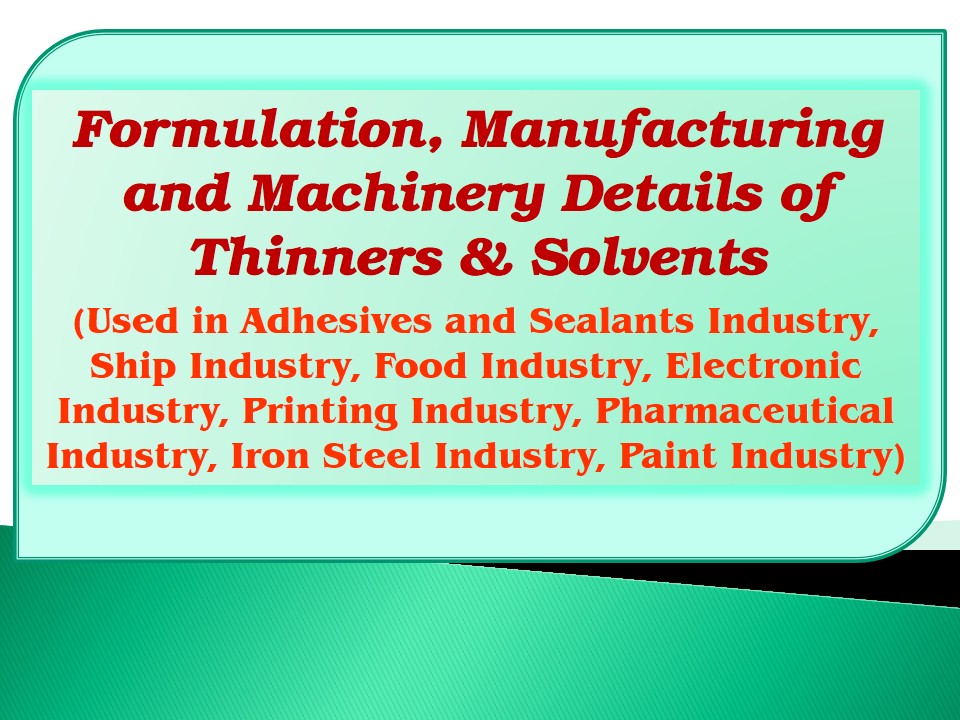
Thinners and solvents are indispensable in the adhesives and sealants industry because they adjust viscosity, aid curing, and improve spreading. Across sectors like shipbuilding, food packaging, electronics, printing, and pharma, formulation manufacturing and machinery details of thinners solvents used in adhesives and sealants industry ship industry food industry electronic industry printing industry pharmaceutical industry ensure consistent performance and regulatory compliance. These chemicals help maintain bond strength, accelerate drying, and enable clean application, ultimately enhancing product quality and operational efficiency.
Understanding Thinners & Solvents: Function and Types
Thinners and solvents reduce the thickness of adhesives and sealants, improving workability and surface coverage. They also facilitate tool cleaning and residue removal post-application. Choose solvents based on volatility, polarity, toxicity, and industry-specific standards.
See More – Printing & Writing Inks
Common Types:
-
Aromatic solvents: toluene, xylene – good solvency but high VOC; used in shipbuilding, printing.
-
Ketones: MEK, acetone – fast-drying, high solvency; ideal for electronics and degreasing.
-
Esters: ethyl acetate, butyl acetate – medium drying; favored in food-grade adhesive lamination.
-
Alcohols: isopropanol, ethanol – mild solvency; used in pharma packaging and cleaning.
-
Hydrocarbons: naphtha/mineral spirits – slower volatilization; used in marine sealants.
Eco-Friendly Alternatives:
-
d-limonene (citrus-based)
-
Methyl soyate
-
Low-VOC or water-based blends
Industry-Wise Applications
Shipbuilding
Thinners enhance polyurethane and epoxy sealants used on hulls and decks. Aromatic solvents degrade residues, degrease, and control viscosity for spray and trowel applications. For cleanup, naphtha and mineral spirits are preferred.
Food Packaging
Strict safety norms demand food-grade solvents such as ethyl acetate and isopropanol. These are used in adhesives for laminated films and cartons, offering quick drying, low odor, and residual safety post-curing.
Electronics Manufacturing
Precision is key here. High-purity acetone and IPA clean PCBs and thin conformal coatings and conductive adhesives. Low surface tension promotes complete substrate wetting. Ultra-low impurity levels prevent corrosion and ensure product reliability.
Printing Industry
Printing inks, flexo, and gravure adhesives use toluene, MEK, and xylene to dissolve binders and control drying. For UV systems, fast-evaporation solvents like n-propyl acetate improve flow and cure efficiency.
Pharmaceutical Sector
This sector demands USP/NF-grade solvents (IPA, ethanol, acetone). They are critical for transdermal adhesive patches, sterile packaging, and medical-grade sealants. Purity and regulatory compliance are essential.
Formulation: Balancing Solvent Blends
A robust thinner blend optimizes performance for specific industries.
Sample Formulations:
-
Marine/Ship Thinner
– 40?% toluene, 30?% xylene, 20?% MEK, 10?% naphtha -
Food-Grade Adhesive Thinner
– 70?% ethyl acetate, 20?% ethanol, 10?% acetone -
Electronics Cleaning Solvent
– 50?% IPA, 50?% acetone (ultra-pure grade)
These blends consider flash point, EPA VOC limits, solvency, and regulatory constraints.
Manufacturing Process Overview
Formulation manufacturing and machinery details of thinners solvents used in adhesives and sealants industry ship industry food industry electronic industry printing industry pharmaceutical industry mirror across sectors:
-
Raw Material Receipt & Storage
– Solvents arrive in ISO tanks or drums and are stored in SS tanks with safety controls. -
Blending
– Precise dosing and mixing under ATEX standards, sometimes with nitrogen blanketing. -
Filtration
– 5–10?µm filters remove particulates. -
Stabilization
– Anti-oxidants, anti-sedimentation agents, or fragrances may be added. -
Quality Testing
– Flashpoint, distillation curve, density, VOC level checks. -
Packaging
– Drums, IBCs, or cans with UN labeling and HAZMAT compliances.
Machinery and Equipment Required
-
Stainless Steel Blending Tanks (500–10?000?L) with agitators
-
Explosion-proof Transfer Pumps (ATEX-certified)
-
Inline Filters (micron-rated)
-
Digital Flow Meters and batch controllers
-
PLC/SCADA Panels for automated batching
-
Filling & Capping Stations for drums & IBCs
-
Fume Hoods & Extraction Systems
Optional units include solvent recovery stills and nitrogen blanketing systems. Facility layout must comply with hazardous area zoning and fire regulations.
Quality Control & Testing
Essential tests include:
-
Density and Specific Gravity via hydrometry
-
Flash Point (Pensky-Martens closed cup)
-
Distillation Range (ASTM D86)
-
Evaporation Test & Solvency trials
-
GC-MS for purity/impurities
-
VOC Content analysis
Advanced labs in pharma and electronics sectors may use GC-MS, Karl Fischer titration, and GC-FID.
Safety and Environmental Compliance
Handling solvents requires strict controls:
-
MSDS and PPE (gloves, goggles, explosion-proof suits)
-
Fire Safety: extinguishers, sprinklers, detectors
-
Ventilation in production & storage areas
-
Hazardous Waste Management: reuse or authorized disposal
-
Regulations: CPCB, Hazardous Waste Rules, ATEX Zone classification
Green alternatives—like bio-solvents and VOC controls—help companies meet environmental goals and consumer expectations.
Market Trends & Growth Drivers
The global adhesive and sealant thinners market is growing at a 4–6% CAGR. Industrial shifts such as greener packaging, rising marine trade, expanding electronics manufacturing, and pharmaceutical growth are fueling demand.
Growing opportunities include:
-
Custom solvent blends tailored to industry specs
-
Contract manufacturing & private labeling
-
Export to GCC, Africa, Asia where industrial growth is high
-
Eco-solvent production aligned with new VOC regulations
Profitability and Business Viability
Entry into solvent blending requires:
-
Capex: ?50?L–?3?Cr depending on scale
-
Opex: ~60% feedstock, 10% utilities, 10% labor, 20% packaging/admin
-
Margins: 10–20% on branded solvents, 5–10% on commoditized blends
-
Volume: Scaling to 500–5?000?t/year improves ROI
-
Breakeven: 2–3?years for mid-size plants with disciplined operations
Contracts in niche sectors (food-grade or electronics) yield higher margins with certification-backed premiums.
See More – Indian Companies Directory
Conclusion
Thinners and solvents are essential to modern adhesives and sealants across industries—from ships and food to electronics, printing, and pharmaceuticals. Understanding the formulation manufacturing and machinery details of thinners solvents used in adhesives and sealants industry ship industry food industry electronic industry printing industry pharmaceutical industry enables entrepreneurs to launch versatile, compliance-ready blending facilities.
By designing precise industry-specific blends, investing in proper equipment, and adhering to rigorous safety and quality standards, businesses can secure steady, long-term contracts across high-value sectors. With environmental regulations encouraging low-VOC and bio-solvents, the market—rooted in industrial chemistry—remains both resilient and ripe for innovation.





